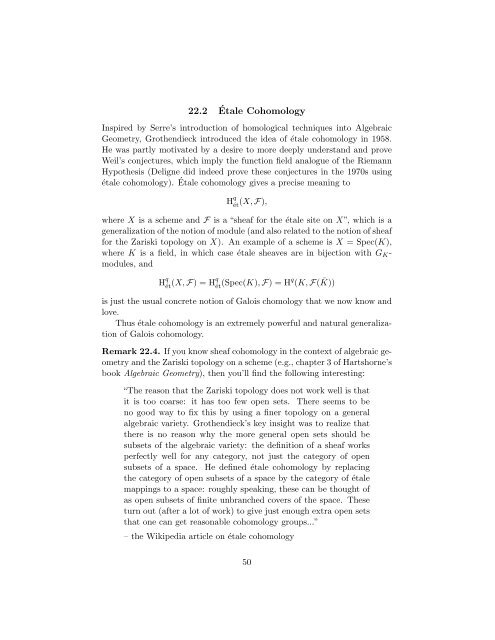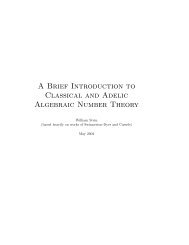A Short Course on Galois Cohomology - William Stein - University of ...
A Short Course on Galois Cohomology - William Stein - University of ...
A Short Course on Galois Cohomology - William Stein - University of ...
Create successful ePaper yourself
Turn your PDF publications into a flip-book with our unique Google optimized e-Paper software.
22.2 Étale <strong>Cohomology</strong><br />
Inspired by Serre’s introducti<strong>on</strong> <strong>of</strong> homological techniques into Algebraic<br />
Geometry, Grothendieck introduced the idea <strong>of</strong> étale cohomology in 1958.<br />
He was partly motivated by a desire to more deeply understand and prove<br />
Weil’s c<strong>on</strong>jectures, which imply the functi<strong>on</strong> field analogue <strong>of</strong> the Riemann<br />
Hypothesis (Deligne did indeed prove these c<strong>on</strong>jectures in the 1970s using<br />
étale cohomology). Étale cohomology gives a precise meaning to<br />
H q<br />
ét (X, F),<br />
where X is a scheme and F is a “sheaf for the étale site <strong>on</strong> X”, which is a<br />
generalizati<strong>on</strong> <strong>of</strong> the noti<strong>on</strong> <strong>of</strong> module (and also related to the noti<strong>on</strong> <strong>of</strong> sheaf<br />
for the Zariski topology <strong>on</strong> X). An example <strong>of</strong> a scheme is X = Spec(K),<br />
where K is a field, in which case étale sheaves are in bijecti<strong>on</strong> with GKmodules,<br />
and<br />
H q<br />
ét (X, F) = Hq<br />
ét (Spec(K), F) = Hq (K, F( ¯ K))<br />
is just the usual c<strong>on</strong>crete noti<strong>on</strong> <strong>of</strong> <strong>Galois</strong> chomology that we now know and<br />
love.<br />
Thus étale cohomology is an extremely powerful and natural generalizati<strong>on</strong><br />
<strong>of</strong> <strong>Galois</strong> cohomology.<br />
Remark 22.4. If you know sheaf cohomology in the c<strong>on</strong>text <strong>of</strong> algebraic geometry<br />
and the Zariski topology <strong>on</strong> a scheme (e.g., chapter 3 <strong>of</strong> Hartshorne’s<br />
book Algebraic Geometry), then you’ll find the following interesting:<br />
“The reas<strong>on</strong> that the Zariski topology does not work well is that<br />
it is too coarse: it has too few open sets. There seems to be<br />
no good way to fix this by using a finer topology <strong>on</strong> a general<br />
algebraic variety. Grothendieck’s key insight was to realize that<br />
there is no reas<strong>on</strong> why the more general open sets should be<br />
subsets <strong>of</strong> the algebraic variety: the definiti<strong>on</strong> <strong>of</strong> a sheaf works<br />
perfectly well for any category, not just the category <strong>of</strong> open<br />
subsets <strong>of</strong> a space. He defined étale cohomology by replacing<br />
the category <strong>of</strong> open subsets <strong>of</strong> a space by the category <strong>of</strong> étale<br />
mappings to a space: roughly speaking, these can be thought <strong>of</strong><br />
as open subsets <strong>of</strong> finite unbranched covers <strong>of</strong> the space. These<br />
turn out (after a lot <strong>of</strong> work) to give just enough extra open sets<br />
that <strong>on</strong>e can get reas<strong>on</strong>able cohomology groups...”<br />
– the Wikipedia article <strong>on</strong> étale cohomology<br />
50
















